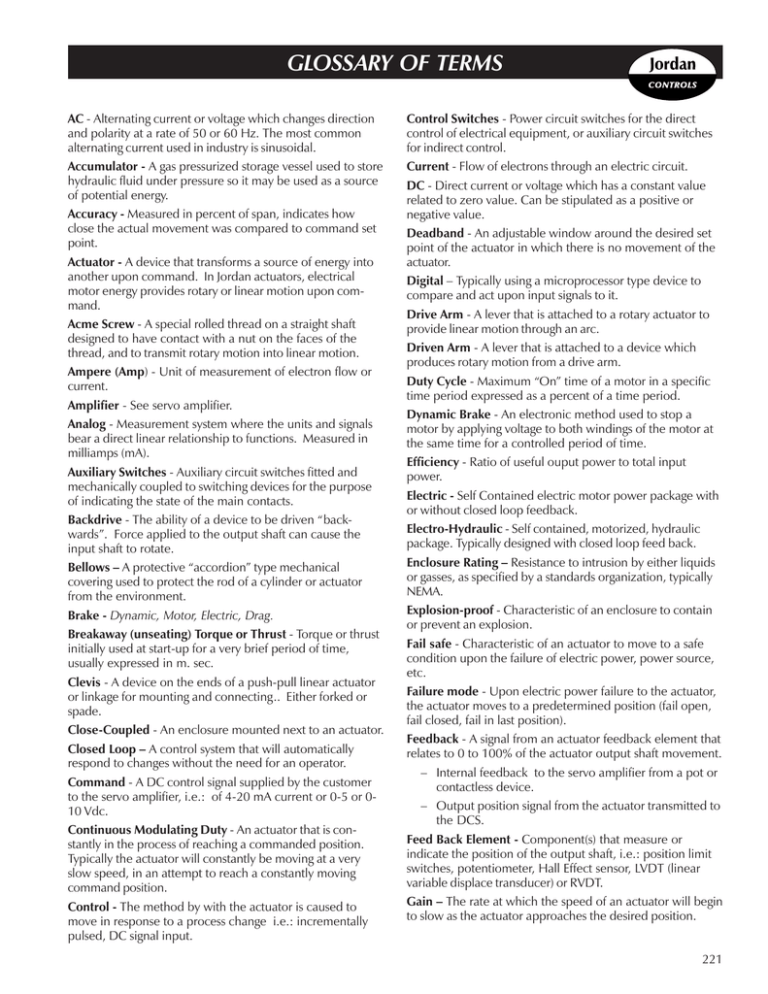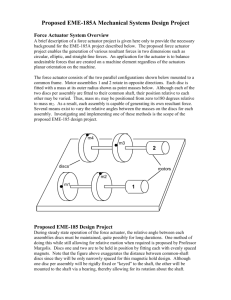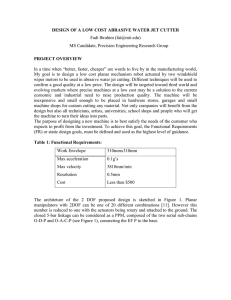GLOSSARY OF TERMS
advertisement

GLOSSARY OF TERMS AC - Alternating current or voltage which changes direction and polarity at a rate of 50 or 60 Hz. The most common alternating current used in industry is sinusoidal. Control Switches - Power circuit switches for the direct control of electrical equipment, or auxiliary circuit switches for indirect control. Accumulator - A gas pressurized storage vessel used to store hydraulic fluid under pressure so it may be used as a source of potential energy. Current - Flow of electrons through an electric circuit. Accuracy - Measured in percent of span, indicates how close the actual movement was compared to command set point. Actuator - A device that transforms a source of energy into another upon command. In Jordan actuators, electrical motor energy provides rotary or linear motion upon command. Acme Screw - A special rolled thread on a straight shaft designed to have contact with a nut on the faces of the thread, and to transmit rotary motion into linear motion. Ampere (Amp) - Unit of measurement of electron flow or current. Amplifier - See servo amplifier. Analog - Measurement system where the units and signals bear a direct linear relationship to functions. Measured in milliamps (mA). Auxiliary Switches - Auxiliary circuit switches fitted and mechanically coupled to switching devices for the purpose of indicating the state of the main contacts. Backdrive - The ability of a device to be driven “backwards”. Force applied to the output shaft can cause the input shaft to rotate. Bellows – A protective “accordion” type mechanical covering used to protect the rod of a cylinder or actuator from the environment. Brake - Dynamic, Motor, Electric, Drag. Breakaway (unseating) Torque or Thrust - Torque or thrust initially used at start-up for a very brief period of time, usually expressed in m. sec. Clevis - A device on the ends of a push-pull linear actuator or linkage for mounting and connecting.. Either forked or spade. Close-Coupled - An enclosure mounted next to an actuator. Closed Loop – A control system that will automatically respond to changes without the need for an operator. Command - A DC control signal supplied by the customer to the servo amplifier, i.e.: of 4-20 mA current or 0-5 or 010 Vdc. Continuous Modulating Duty - An actuator that is constantly in the process of reaching a commanded position. Typically the actuator will constantly be moving at a very slow speed, in an attempt to reach a constantly moving command position. Control - The method by with the actuator is caused to move in response to a process change i.e.: incrementally pulsed, DC signal input. DC - Direct current or voltage which has a constant value related to zero value. Can be stipulated as a positive or negative value. Deadband - An adjustable window around the desired set point of the actuator in which there is no movement of the actuator. Digital – Typically using a microprocessor type device to compare and act upon input signals to it. Drive Arm - A lever that is attached to a rotary actuator to provide linear motion through an arc. Driven Arm - A lever that is attached to a device which produces rotary motion from a drive arm. Duty Cycle - Maximum “On” time of a motor in a specific time period expressed as a percent of a time period. Dynamic Brake - An electronic method used to stop a motor by applying voltage to both windings of the motor at the same time for a controlled period of time. Efficiency - Ratio of useful ouput power to total input power. Electric - Self Contained electric motor power package with or without closed loop feedback. Electro-Hydraulic - Self contained, motorized, hydraulic package. Typically designed with closed loop feed back. Enclosure Rating – Resistance to intrusion by either liquids or gasses, as specified by a standards organization, typically NEMA. Explosion-proof - Characteristic of an enclosure to contain or prevent an explosion. Fail safe - Characteristic of an actuator to move to a safe condition upon the failure of electric power, power source, etc. Failure mode - Upon electric power failure to the actuator, the actuator moves to a predetermined position (fail open, fail closed, fail in last position). Feedback - A signal from an actuator feedback element that relates to 0 to 100% of the actuator output shaft movement. – Internal feedback to the servo amplifier from a pot or contactless device. – Output position signal from the actuator transmitted to the DCS. Feed Back Element - Component(s) that measure or indicate the position of the output shaft, i.e.: position limit switches, potentiometer, Hall Effect sensor, LVDT (linear variable displace transducer) or RVDT. Gain – The rate at which the speed of an actuator will begin to slow as the actuator approaches the desired position. 221 GLOSSARY OF TERMS Gear Ratio - Ratio of number of turns the input device takes to rotate the output device one turn. Gearbox - A mechanical device that typically transforms high speed, low torque rotary motion into low speed, high torque rotary motion. Hazardous environment - Any combination of combustible or potentially explosive mixtures existing in the surrounding atmosphere. NEMA Classification - Code established for the construction of electrical components by the National Electrical Manufacturers Association. Null - Output of servo amplifier at rest or off when feedback signal matches command signal within deadband window. Planetary Gears - A type of gear reduction where spur gears rotate around the axis of a central spur gear. Hertz Unit of Frequency - Number of times per second that alternating current flows in one direction, reverses, and flows in the other direction. Power companies in the United States hold this figure constant at 60 cycles per second (hertz). Plug Reversal – Immediate reversing of a motor without allowing the shaft to stop. Hydraulic - Pressurized fluid (oil) used for power transmission incorporating a hydraulic power unit, hoses, and a cylinder or motor. Typically designed with out closed loop feed back. Potentiometer - A three terminal, variable resistance device, that when turning the potentiometer shaft will result in a varying resistance. Hysteresis - Measured effect of the delay in action due to compressive or elastic effects. IGBT – Insulated Gate Bipolar Transistor Incremental Control – Control that uses ON and OFF pulses, either automatically generated, or by an operator. In-rush Current - Current draw of a motor on starting. Limit Switch - Set of electric contacts that are activated mechanically. Linear Travel - Movement in a straight line. Linearity - Maximum deviation from best straight line representing ratio of output amplitude to input amplitude. Lock-in-Place (LIP) – Refers to stopping when an event occurs. Loop Control - A process management system designed to maintain a process variable at a desired set point. Loss of Signal (LOS) – An absence of a command, or demand, signal. Manual Override - Capability provided to actuators that allows the manual positioning of the actuator. Also known as handcrank. Milliamp (mA) – A measure of electric current, one thousandth of an ampere. Modulating - Regulating or adjusting a control element proportional to a process change. Modulation Rate - Number of actuator starts (cycles) per hour. Minimum off-time of actuator is one-half of a cycle. (Example: If actuator is rated at 1200 starts/hr, this is 3 seconds per cycle, therefore minimum off-time is 1.5 sec.) Moment Arm - Linear distance from the center of rotation upon which a force may act to produce torque. Multi-Turn/Rising Stem - Describes a valve that requires multiple turns of the actuator output shaft to raise and lower the stem of a valve using a threaded portion of the stem. 222 Position/Limit Switch - A mechanically tripped switch used to limit end travel movement, or to trip at a desired position. Power Supply - There are two types of power supply: direct current and alternating current. The latter is the most widely used power supply. Pneumatic - Compressed air used for power or control of devices utilizing clean dry instrument air. Position Accuracy - See Accuracy. Power - Input voltage required to drive the actuator i.e.: 120vAC/1ph/60hz. Process Control - Act of maintaining or correcting a process within preset limits using a measurement of the actual process conditions in comparison to an established, desired condition. Proportional Controller - Provides a response from an actuator that is directly related to the feedback from a remote sensor. Used to control a process automatically. Rack - Linear gear that operates in conjunction with a pinion gear to provide rotary motion. Repeatability - Measured accuracy in percent of span of a control device to match a set point when approaching from either direction. Resolution - Smallest possible movement that can be measured. Rotary Actuator - Device that provides rotating movement to a final control element. Scotch Yoke - Method of converting linear motion to rotary motion by using a slotted lever arm. Seat - That portion of the seat ring or valve body which a valve closure member contacts for closure. Seating Torque - Value depicting the turning force required to seat a valve or damper into its closed position. Self-Locking - The ability of a device to counteract the effects of gravity. An actuator that is self-locking will hold a load from lowering. GLOSSARY OF TERMS Servo Amplifier - An electronic device used to control actuator output shaft position based on the difference between command and feedback signal. Stability - Ability of an actuator to not show a change in position when subjected to extraneous input like electronic noise, temperature or vibration. Shift Time - Actuator travel time in seconds for 0 - 100% travel. Throttling - Action of an actuator in modulating motion. Span - The high end adjustment for a signal input to a servo amplifier. aka: Range or High Trim. Splined Shaft - A shaft with raised areas to positively transmit torque. Could be thought of as multiple keys/ keyway. Split Command Input – A system whereby multiple actuators move in sequence with each other. Spring-return Actuator - Device that contains a spring element having the capability of returning a valve-actuator system to its normal position in the absence of electric power. Spur Gearing - Method of transferring torque from one shaft to another. Usually results in a decrease in speed with an increase in torque. Thrust - A linear force acting on an object, causing motion, measured in lbs., or Newtons Thrust Limiting – A mechanical device inside the actuator which stops the actuator if the maximum thrust rating is exceeded. Torque - A twisting force acting on a shaft, resulting in rotation, measured in in-lbs., ft-lbs.,or Nm. Torque Limiting - A mechanical device inside the actuator which stops the actuator if the maximum torque rating is exceeded. Triac – An electronic device which serves as an AC switch. Unrestricted Modulating Duty - See modulating duty. Valves - Butterfly, globe, plug, ball, etc. Zero - Low end adjustment for signal input, aka: Low Trim. 223





